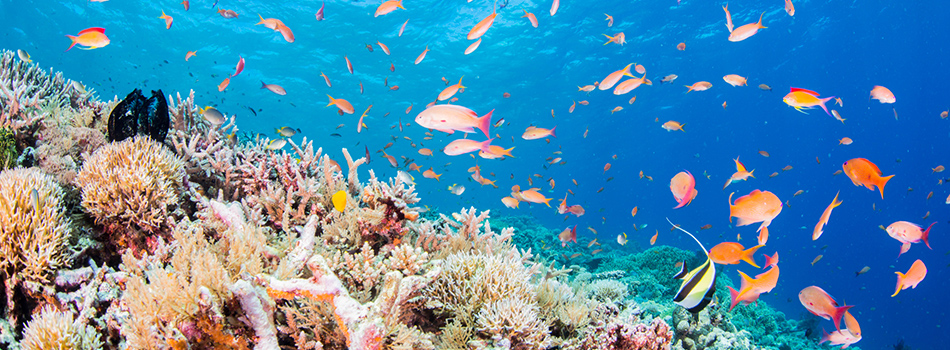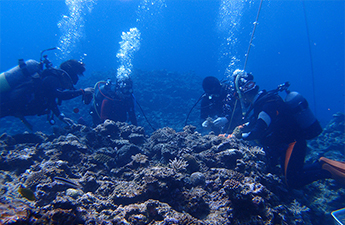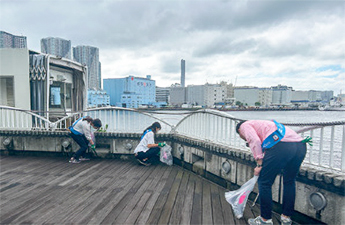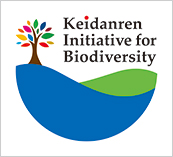Biodiversity Conservation


Corporate activities receive the benefits of ecosystem services provided by biodiversity and natural capital, while simultaneously impacting the environment in some way. The Company recognizes the importance of biodiversity conservation and supports the international community's goal of achieving “Nature Positive.” We consider minimizing the impact of our corporate activities on ecosystems as one of our material issues and are committed to promoting initiatives aimed at achieving no net loss, including offset activities related to biodiversity conservation.
In order to ensure a sustainable planet with functioning ecosystems for future generations, we promote initiatives based on this policy within our business operations, and ask all of our suppliers (tier-1 and non tier-1) and business partners to cooperate with our biodiversity initiatives as well. We also engage with stakeholders to promote biodiversity conservation initiatives through business activities and social contribution activities.
Response to TNFD recommendations

TNFD (Taskforce on Nature-related Financial Disclosures) is an international organization that establishes a framework for appropriately assessing and disclosing risks and opportunities related to natural capital and biodiversity. As a company adopting the TNFD's disclosure recommendations published in September 2023, we registered early as a TNFD Adopter in December 2023. Based on the disclosure framework outlined in the TNFD's recommendations, we are committed to proactive information disclosure.
Major initiatives
Protecting the marine
environment
through activities
to conserve coral

As part of our environmental conservation efforts which include measures to combat global warming and ecosystem maintenance, we launched the “Future and Coral Project” in July 2019 together with Onna Village in Okinawa Prefecture and many companies and organizations to plant coral and actively conserve the environment.
In order to protect the corals and maintain the future ecosystem of the planet, this project collects donations and purchases coral seedlings with such funds, arranges volunteer tours to plant those seedlings and activities to clean up nearby beaches, and disseminates information about coral growth, cooperating companies, and the activities of the organization.
The Sunshine Aquarium, which has been involved in coral conservation and research, has provided academic support since the project's inception, and we will continue to deepen our relationship.
Our stance on achieving zero deforestation
The Company recognizes that its business activities benefit from ecosystem services provided by biodiversity and natural capital, and acknowledges the importance of biodiversity conservation and zero deforestation for sustainable corporate management.
However, in order to deliver telecommunications services broadly and reliably as part of social infrastructure, the Company occasionally needs to modify land to install base stations and related equipment.
The Company is committed to avoiding land development in areas of significant biodiversity. In cases where development is unavoidable, the Company takes actions that carefully consider the potential impact on ecosystems. In cases where significant impact on critical ecosystems is anticipated, we strive to minimize and restore the damage.
Furthermore, in order to pass on a biodiversity-rich and sustainable planet to future generations, we aim to prevent deforestation by 2030 through activities such as tree planting. This initiative is promoted not only within our own operations but also across our value chain, with the cooperation and understanding of suppliers and business partners.
The Company has established an ESG Promotion Committee as an advisory body to the Board of Directors, setting initiatives related to biodiversity and natural capital conservation as materiality KPIs. The Company's President & CEO serves as Chief ESG Promotion Officer, bearing final accountability for overall sustainability efforts under Board oversight. The Company has also established an Environment Committee under the Executive Officer in charge of ESG promotion to drive internal implementation and execution of these initiatives, including achieving zero deforestation.
Environmental conservation tree planting initiatives with our customers

We offer the “Charity Smile” program to support environmental conservation initiatives across Japan. Through this initiative, customers contribute ¥10 each month, and we match that amount with an additional ¥10 from our company, resulting in a total monthly donation of ¥20 per participant.
This initiative is offered as part of the consumer-participation reforestation contribution program “NatureBank.” With a modest monthly contribution of ¥10 conveniently added to customers' regular mobile phone bills, it enables ongoing support with minimal burden. In the event of major natural disasters, whether in Japan or overseas, a portion of the donations is also allocated to relief efforts in the affected areas.
Declaration of zero paper for internal operations
To promote paperless operations, we have declared a “Zero Paper Usage for Internal Operations” policy since April 2012. We have actively worked to reduce the use of paper in applications, reports, meeting materials, and other documents used for internal and external procedures. As a result, we have achieved a significant reduction of 90% compared to FY2011. Additionally, starting in April 2021, we have launched the “Electronic Seal Project” aimed at improving operational efficiency and are striving to reduce the impact on deforestation.
Tree planting activities by employees

We host the “Summer Vacation Parent-Child Nature School” with the cooperation of the “NPO CCC Furano Nature School” led by Mr. Sou Kuramoto. This program, aimed at employees and their children, focuses on themes such as “Building Healthy Parent-Child Relationships” and “Thinking about the Environment and Nature.”
Since its inception in 2007, more than 250 parents and children have participated in a total of seven programs related to the environment, including two of our original programs. We carry out future-oriented activities, such as removing the turf from golf courses and planting saplings in the soil to restore the land to its original forested state. Through these experiences, we aim to deepen the bonds between parents and children while providing opportunities to reflect on the current state of the Earth and consider what we can do for future environmental conservation.
Waste cleanup activities by employees

The Takeshiba Area Management Association leads monthly cleanup activities to beautify the land around our headquarters. The Takeshiba area includes the “Takeshiba Tideland,” where diverse organisms live, and employees contribute to environmental conservation by removing plastic that has drifted ashore here and other trash as part of these cleanup activities.
Use of certified paper

All of the paper bags with our logo that our employees use for sales and other activities are made of recyclable materials. In addition to the elimination of plastic on the surface of the bags, plastic is also not used for the handles. The joints between the bags are also tied together without using any adhesives or fasteners. The paper is recyclable and certified by the FSC® (Forest Stewardship Council®), an international non-profit organization established to promote responsible forest management worldwide. For logo printing, we now use vegetable ink, which is biodegradable compared to petroleum-based solvents and contributes to a reduction in environmental impact with almost no emissions of volatile organic compounds.
Preventing deforestation and other environmental destruction
through mobile phone recycling
Our core business products, such as mobile phones, batteries, and chargers, contain a variety of valuable resources, including rare metals (such as palladium and cobalt) as well as gold, silver, and copper. Rare metals are not only essential raw materials but are also difficult to substitute. New mining operations will have an impact on the biodiversity of the producing areas due to mine development and other factors. Since rare metals can be collected more efficiently through recycling than through mining, the Company promotes the collection and recycling of used mobile phones. By advancing recycling efforts, we contribute to preventing environmental destruction, such as deforestation from new mining activities.
Environmental conservation and preservation of traditional crafts through the utilization of kudzu

Kudzu is highly resilient and spreads rapidly, often disrupting landscapes and ecosystems, and in some cases even contributing to natural disasters. On the other hand, it has long been used as a raw material for products such as kudzu powder, kudzu fabric, and herbal remedies like kakkonto (kudzu root tea), and it also holds environmental value by absorbing CO2 during its growth process.
We are a member of the Kudzu Utilization Consortium, established with the aim of preserving the traditional craft of kuzufu (kudzu fabric) in Kakegawa City, Shizuoka Prefecture, while promoting sustainable global environmental conservation by harnessing the dual nature of kudzu.
Within the consortium, kudzu is processed into pellets to be used as a raw material for paper products, among other applications. The consortium explores various ways to utilize kudzu across different fields to create products and promote their use. A portion of the proceeds from these products is allocated to support the training of future artisans, thereby contributing to the development of human resources in the kuzufu (kudzu fabric) industry.
Through a circular approach to the utilization of kudzu, we support the sustainable preservation of both nature and traditions.
Participation in initiatives
Joining the TNFD Forum

We have endorsed the principles of the Task Force on Nature-related Financial Disclosures (TNFD), and have joined the TNFD Forum in May 2022. We will actively promote information disclosure based on the disclosure framework.
Participated in the Ministry of
the Environment's
30 by 30 Alliance for Biodiversity

Participated in the 30 by 30 Alliance for Biodiversity, a group of companies, local governments, NPOs, and others working to achieve the 30 by 30 goal of conserving 30% of land and sea by 2030.
Join the Japan Business Initiative
for Biodiversity (JBIB)

We are a network member of the Japan Business Initiative for Biodiversity (JBIB), a group of companies that are actively working to conserve biodiversity.
We will continue to engage in biodiversity conservation activities and promote activities that are consistent with global trends.
Endorsement of the
“Initiative based on the
Declaration of Biodiversity
by Keidanren”


In addition to participating in the Keidanren Council on Nature Conservation, we endorse the aims of the “Declaration of Biodiversity by Keidanren” formulated by Keidanren, and have endorsed the “Initiative based on the Declaration of Biodiversity by Keidanren.”